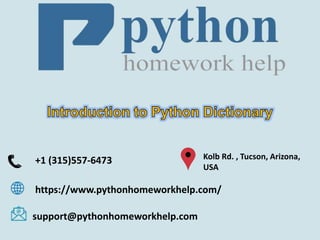
Introduction to Python Dictionary.pptx
- 1. +1 (315)557-6473 https://www.pythonhomeworkhelp.com/ support@pythonhomeworkhelp.com Kolb Rd. , Tucson, Arizona, USA
- 2. Problem 1 – Names and Ages Define two lists at the top of your file: NAMES = [“Alice”, “Bob”, “Cathy”, “Dan”, “Ed”, “Frank”, “Gary”, “Helen”, “Irene”, “Jack”, “Kelly”, “Larry”] AGES = [20, 21, 18, 18, 19, 20, 20, 19, 19, 19, 22, 19] These lists match up, so Alice’s age is 20, Bob’s age is 21, and so on. Write a program that combines these lists into a dictionary. Then, write a function that, given an age, returns the names of all the people who are that age. Test your program and function by running these lines: (replace people with your function) print people(18) == [“Cathy”, “Dan”] print people(19) == [“Ed”, “Helen”, “Irene”, “Jack”, “Larry”] print people(20) == [“Alice”, “Frank”, “Gary”] print people(21) == [“Bob”] print people(22) == [“Kelly”] print people(23) == [] All lines should print True. If the last line is giving you an error, look at the name of the error.
- 3. Solution: NAMES = ["Alice", "Bob", "Cathy", "Dan", "Ed", "Frank", "Gary", "Helen", "Irene", "Jack", "Kelly", "Larry"] AGES = [20, 21, 18, 18, 19, 20, 20, 19, 19, 19, 22, 19] # Put code here that will combine these lists into a dictionary ages_to_names = {} for i in range(len(NAMES)): name = NAMES[i] age = AGES[i] if age in ages_to_names: ages_to_names[age].append(name) else: ages_to_names[age] = [name] # the LIST containing the name # You can rename this function def people(age): """ Return the names of all the people who are the given age. """ if age in ages_to_names: return ages_to_names[age] return []
- 4. # Testing print people(18) == ["Cathy", "Dan"] print people(19) == ["Ed", "Helen", "Irene", "Jack", "Larry"] print people(20) == ["Alice", "Frank", "Gary"] print people(21) == ["Bob"] print people(22) == ["Kelly"] print people(23) == [] Problem 2 - The inventory shows eight different items, each having a name, a price and a count, like so: HAMMER = “hammer” HAMMER_PRICE = 10 HAMMER_COUNT = 100 We’re going to consider that customers generally come in with an idea of how much money they want to spend. So we’re going to think of items as either CHEAP (under $20), MODERATE (between $20 and $100) or EXPENSIVE (over $100). First, fill in the variable inventory so that all of the data for the eight items is inside inventory. Make sure that you maintain the notion of CHEAP, MODERATE and EXPENSIVE. Then, implement the function get_info that takes a cheapness and returns a list of information about each item that falls under that category, as the function’s information says.
- 5. When you’re finished, just run the program. All of the testing lines should print True. Solution: CHEAP = "cheap" # less than $20 MODERATE = "moderate" # between $20 and $100 EXPENSIVE = "expensive" # more than $100 HAMMER = "hammer" HAMMER_PRICE = 10 HAMMER_COUNT = 100 SCREW = "screw" SCREW_PRICE = 1 SCREW_COUNT = 1000 NAIL = "nail" NAIL_PRICE = 1 NAIL_COUNT = 1000 SCREWDRIVER = "screwdriver" SCREWDRIVER_PRICE = 8 SCREWDRIVER_COUNT = 100
- 6. DRILL = "drill" DRILL_PRICE = 50 DRILL_COUNT = 20 WORKBENCH = "workbench" WORKBENCH_PRICE = 150 WORKBENCH_COUNT = 5 HANDSAW = "handsaw" HANDSAW_PRICE = 15 HANDSAW_COUNT = 50 CHAINSAW = "chainsaw" CHAINSAW_PRICE = 80 CHAINSAW_COUNT = 30 # You should put the stuff logically into this dictionary. # You can just put it all in right here, like shown. # Try to use only one *variable*, called inventory here. inventory = { CHEAP : { HAMMER : (HAMMER_PRICE, HAMMER_COUNT), NAIL : (NAIL_PRICE, NAIL_COUNT),
- 7. SCREW : (SCREW_PRICE, SCREW_COUNT), SCREWDRIVER : (SCREWDRIVER_PRICE, SCREWDRIVER_COUNT), HANDSAW : (HANDSAW_PRICE, HANDSAW_COUNT) }, MODERATE : { DRILL : (DRILL_PRICE, DRILL_COUNT), CHAINSAW : (CHAINSAW_PRICE, CHAINSAW_COUNT) }, EXPENSIVE : { WORKBENCH : (WORKBENCH_PRICE, WORKBENCH_COUNT) } } def get_items(cheapness): """ Return a list of (item, (price, count)) tuples that are the given cheapness. Note that the second element of the tuple is another tuple. """ return inventory[cheapness].items() # Testing cheap = get_items(CHEAP) print type(cheap) is list print len(cheap) == 5 print (HAMMER, (HAMMER_PRICE, HAMMER_COUNT)) in cheap
- 8. print (NAIL, (NAIL_PRICE, NAIL_COUNT)) in cheap print (SCREW, (SCREW_PRICE, SCREW_COUNT)) in cheap print (SCREWDRIVER, (SCREWDRIVER_PRICE, SCREWDRIVER_COUNT)) in cheap print (HANDSAW, (HANDSAW_PRICE, HANDSAW_COUNT)) in cheap moderate = get_items(MODERATE) print type(moderate) is list print len(moderate) == 2 print (DRILL, (DRILL_PRICE, DRILL_COUNT)) in moderate print (CHAINSAW, (CHAINSAW_PRICE, CHAINSAW_COUNT)) in moderate expensive = get_items(EXPENSIVE) print type(expensive) is list print len(expensive) == 1 print (WORKBENCH, (WORKBENCH_PRICE, WORKBENCH_COUNT)) in expensive
